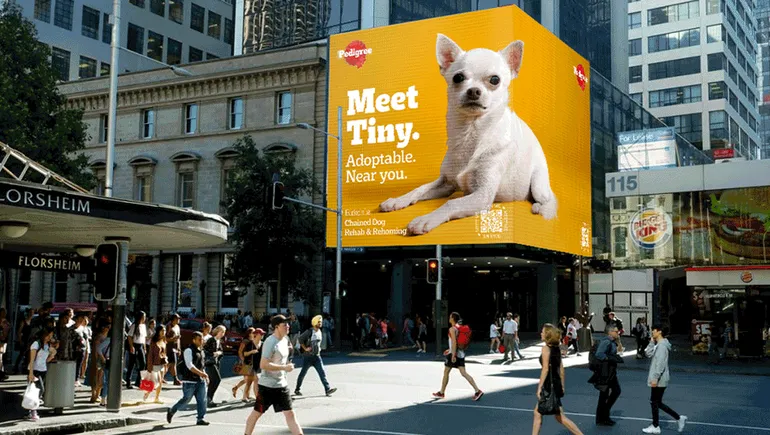
Campaign Trail: Trade Coffee’s remotely produced ad embodies creativity in crisis
Campaign Trail is our analysis of some of the best and worst new creative efforts from the marketing world. View past columns in the archives here.
Coffee is a key part of culture and people’s daily lives. It’s a common connector around which people socialize and network — meeting over the office coffee pot or hatching ideas in a café. Despite the pandemic temporarily closing some roasteries and upending commuters’ grab-and-go habits, consumers stuck at home are still enjoying their daily brew, a new ad by direct-to-consumer (DTC) coffee company Trade contends.
The 30-second spot — produced entirely remotely — that debuted last week features a dozen Trade employees gathering virtually and closes with the line, “At least we have coffee.” While the “Brew From Home, Together” video mirrors how stir-crazy consumers are turning to digital platforms like Zoom to connect with loved ones and colleagues while social distancing, it also illustrates how brands are navigating the uncharted waters of producing creative work remotely.
“We noticed how our own habits and ways of connecting as a company were transitioning to digital platforms, but we were still able to connect and experience growth together while being remote,” Trade CMO Melissa Spencer Barnes told Marketing Dive. “That sparked this idea around how even though we’re separated, we can still unite over coffee.”
Coffee as a connector
Campaigns typically require significant planning and preparation, with agency partnerships, concept pitches and production occurring months before launch. But with the pandemic keeping staff and creative agencies indoors, brands like Trade must nimbly adapt when developing fresh marketing efforts.
“I feel really proud of the final result because it captures the way a lot of people are feeling during quarantine,” Barnes said. “We’re a small and close-knit team that was suddenly all in different places, so this came about in the early days when we were still adjusting to such an extremely different set of circumstances.”
Barnes’ team first contacted studio Cause & Effect’s Micah Perta on a Saturday in March, and within six days, the 30-second spot was finalized. The technical feat materialized when Perta asked the Trade employees questions about their coffee habits and the bizarre life of quarantining, directing them live as they each recorded their own frame.
“It was still very interactive like the way directing normally would be, but a totally interesting experience because we were all reacting to each other live on the screen in our separate homes,” said Barnes, who appears first in the spot while making espresso.
By enlisting Trade employees and directing the video live via mobile phones, the ad possesses an authenticity that may resonate with consumers who relate to being stuck inside brewing their own coffee.
“It feels real because it is real. These really are people who work together and connect with each other on a regular basis, so this was our attempt to bring that authenticity in,” Barnes said. “People are pretty savvy nowadays and can sniff out the difference between something created authentically and something that’s not.”
Sparking creativity at home
Perta’s directing the shoot live as the talent — in this case, Trade employees — take cues and share their home brewing tips demonstrates a novel creative approach to production amid widespread studio closures. Brands, agencies and production studios around the world are experimenting with how to continue business as usual and create fresh marketing campaigns during the pandemic. Ford, Toyota and Hyundai, for instance, used archival footage and recut the clips with new messages to develop original ads that better align with the current environment.
But for two-year-old Trade, stripping away extraneous elements and preparation brought the team back to the basics of creativity.
“There was something almost liberating without the protocols and red tape and bureaucracy that come with more traditional production. It felt more like pure creativity because we were working with what we had, and I think the constraint actually benefited the creative,” said Barnes, who worked for agency BBDO New York for nearly seven years shooting “big expensive ads.”
“There was something almost liberating without the protocols and red tape and bureaucracy that come with more traditional production.”
Melissa Spencer Barnes
Trade Coffee Co., CMO
Trade is unique in that its products are always consumed in the home. That makes it easy for employees to snap photos of coffee equipment and consumption without needing to stage product photo shoots. Barnes’ team has featured employee-generated visuals in marketing emails and the like, exemplifying one way brands can dabble in producing assets remotely with common tools like a smartphone.
Purpose and agility
With one remotely produced video under its belt, the Trade team “is feeling liberated” to explore more ads like “Brew From Home, Together” in the future, Barnes said, adding that marketers must be open to shifting their tried-and-true strategies for brainstorming creative concepts amid these uncertain times.
“As a startup, we’re fortunate to be very adaptable and nimble and able to adjust to how things are unfolding in our world,” she said.
Deftly pivoting to infuse a campaign’s messaging with purpose can forge even deeper ties with consumers, especially as they increasingly look to purchase from businesses that are doing good and supporting the local community. Trade tweaked the “Brew From Home, Together” spot last minute to add a call-to-action around a new fundraising effort that encourages viewers to tip baristas who are out of work during the closures — a move that may appeal to consumers who want to help others in a time of need. On March 3, dairy giant Chobani joined Trade in matching donations up to $20,000.
“It really goes to show that some of the fancy production is not necessary. All you need is your idea and getting past perceived constraints of not having talent or a location,” Barnes said. “Some of the best work is done under major financial and time constraints. I hope that, ideally, this will become a great time for creativity and tapping into what people really need right now and not just carrying on as business as usual.”





